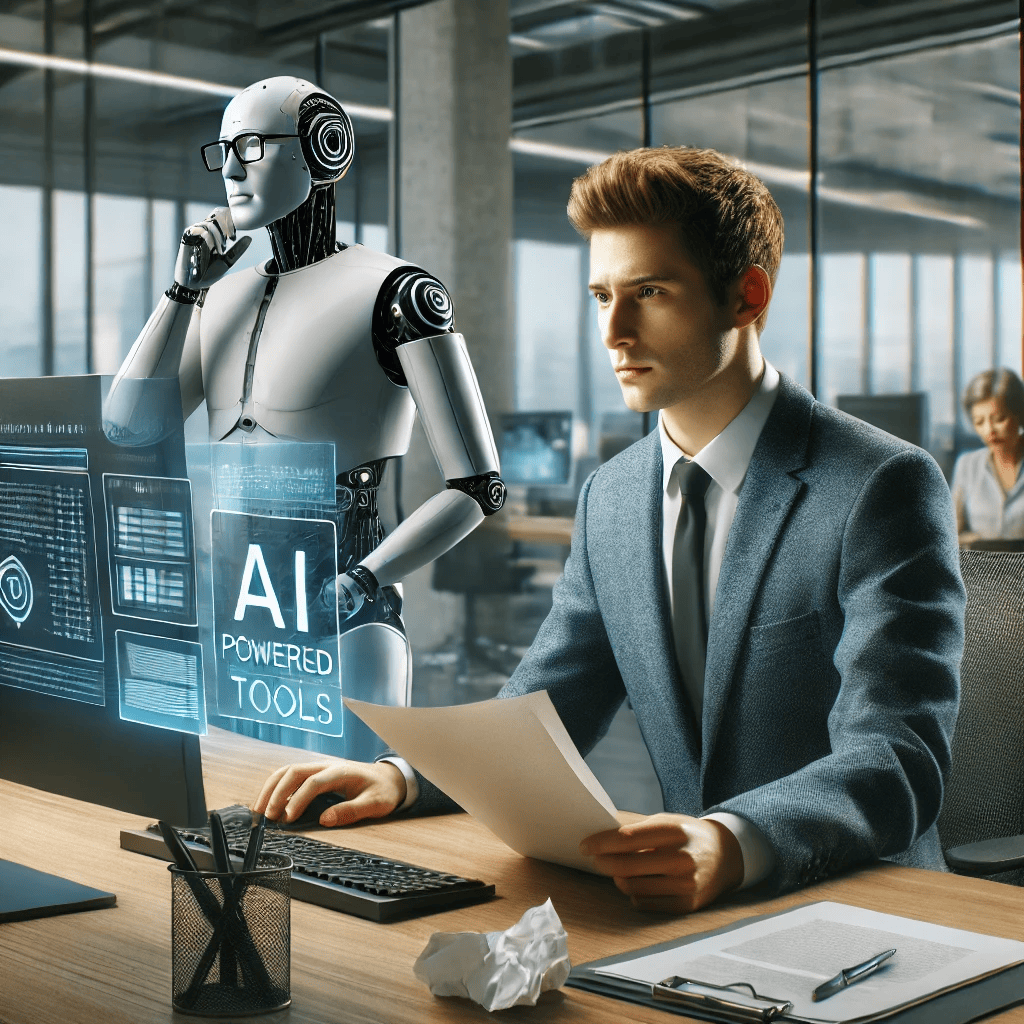If You Aren’t Using AI, You’re Falling Behind According To The U.S. Patent And Trademark Office
Artificial Intelligence has fundamentally transformed the landscape of innovation and technological advancement, as revealed by groundbreaking data from the United States Patent and Trademark Office (USPTO). In a comprehensive analysis of patent applications from 2018, the findings demonstrate an unprecedented surge in AI integration across multiple sectors, with more than 42% of all technology areas now incorporating some form of artificial intelligence in their new inventions. This remarkable statistic not only highlights the growing prominence of AI but also serves as a wake-up call for organizations that have yet to embrace this transformative technology.
We strongly recommend that you check out our guide on how to take advantage of AI in today’s passive income economy.
Table of Contents
The Current State of AI Integration
The USPTO’s detailed examination of patent applications has unveiled a fascinating trend in how businesses are leveraging artificial intelligence across different domains. Knowledge processing and planning/control applications have emerged as the primary areas where AI is making substantial inroads. These developments represent a significant shift in how organizations approach data analysis and business process management, with AI-driven solutions becoming increasingly sophisticated and integral to modern business operations.
Understanding the Impact of AI on Patent Applications
The implications of this technological revolution extend far beyond mere statistics. The USPTO’s report indicates a fundamental shift in how the patent office evaluates and processes applications involving artificial intelligence. This change marks a departure from previous approaches, where software-based innovations often faced significant hurdles in securing patent protection. The current landscape presents a more favorable environment for AI-related patents, opening new opportunities for businesses to protect their technological innovations.
Critical AI Components for Modern Businesses
Planning and Control Systems
In the realm of planning and control, artificial intelligence has demonstrated remarkable capabilities in optimizing workflows and predicting potential operational challenges. The USPTO report highlights sophisticated systems that can analyze visual, auditory, and environmental data to identify and address potential issues before they escalate. This proactive approach to problem-solving has particularly revolutionized supply chain management, where AI-driven systems can significantly enhance operational efficiency and reduce potential disruptions.
Knowledge Processing Applications
The evolution of knowledge processing capabilities represents one of the most significant advances in artificial intelligence applications. Modern AI systems can process and analyze massive datasets with unprecedented speed and accuracy, enabling organizations to uncover valuable insights that would be impossible to detect through traditional methods. Financial institutions have been early adopters of this technology, implementing AI-powered systems for fraud detection and automated accounting reconciliation.
Hardware Infrastructure Development
The hardware component of AI implementation has become increasingly crucial as organizations seek to build robust infrastructure capable of supporting advanced artificial intelligence applications. The USPTO report emphasizes the growing importance of specialized AI hardware solutions that can efficiently process complex algorithms and handle massive data workloads. This aspect of AI integration requires careful consideration from technology leaders as they plan their computing infrastructure investments.
Vision Systems Innovation
The integration of AI-powered vision systems represents a particularly transformative development across multiple industries. In healthcare, artificial intelligence has revolutionized diagnostic processes through advanced image analysis capabilities. These systems can process medical imaging data with remarkable precision, helping healthcare providers identify subtle abnormalities that might be missed through traditional analysis methods. Beyond healthcare, manufacturing sectors have embraced AI vision systems for quality control purposes, implementing sophisticated inspection processes that can detect microscopic defects at speeds far exceeding human capability.
Machine Learning Advancements
The USPTO report emphasizes the growing sophistication of machine learning applications across various industries. While there is some overlap with knowledge processing systems, machine learning represents a distinct category of artificial intelligence that focuses on developing systems capable of improving their performance through experience. Organizations implementing machine learning solutions have reported significant improvements in their predictive analytics capabilities, customer service operations, and process optimization efforts. The patent office’s data suggests that companies investing in machine learning technologies are particularly well-positioned to maintain competitive advantages in their respective markets.
Speech Recognition Technologies
The evolution of speech recognition systems has moved far beyond simple voice command applications. Modern AI-powered speech systems can analyze vocal patterns, emotional undertones, and linguistic nuances to provide enhanced customer service experiences. The USPTO report highlights how organizations are implementing these technologies to create more responsive and efficient customer service operations. These systems can automatically route inquiries to appropriate departments, provide real-time feedback to service representatives, and even predict customer satisfaction levels based on vocal analysis.
Strategic Recommendations for Business Leaders
The comprehensive nature of the USPTO report provides clear direction for organizations looking to enhance their competitive position through artificial intelligence integration. The data suggests that companies should prioritize AI implementation across multiple operational areas rather than focusing on isolated applications. This holistic approach to AI integration can help organizations maximize the benefits of this transformative technology while ensuring they maintain pace with industry leaders.
Implementation Strategies for Success
The process of integrating artificial intelligence into existing business operations requires careful planning and strategic execution. Organizations must first assess their current technological capabilities and identify specific areas where AI integration can provide the most significant impact. This assessment should consider factors such as data availability, processing requirements, and potential return on investment. The USPTO report suggests that successful AI implementations often begin with pilot programs in specific departments before expanding to broader organizational adoption.
Measuring Success and ROI
Establishing clear metrics for measuring the success of AI integration initiatives is crucial for maintaining organizational support and justifying continued investment. The patent office’s analysis reveals that companies achieving the greatest success with artificial intelligence implementation typically focus on both quantitative and qualitative metrics. These measurements might include improvements in operational efficiency, reduction in error rates, increased customer satisfaction scores, and enhanced employee productivity levels. Organizations should develop comprehensive monitoring systems to track these metrics and adjust their AI integration strategies accordingly.
Future Considerations and Trends
The rapid pace of artificial intelligence development means that organizations must remain vigilant about emerging trends and technological advances. The USPTO report indicates several areas of particular interest for future development, including:
- Enhanced Natural Language Processing capabilities that will enable more sophisticated human-computer interactions
- Advanced evolutionary computation methods that could revolutionize problem-solving approaches
- Improved integration between different AI components to create more comprehensive and effective systems
- Continued development of specialized AI hardware to support increasingly complex applications
Building a Culture of Innovation
Success in AI integration extends beyond technological implementation to include cultural transformation within organizations. Companies must foster an environment that embraces artificial intelligence as a tool for enhancement rather than replacement. This includes developing comprehensive training programs, establishing clear communication channels for feedback and suggestions, and creating opportunities for employees to participate in AI-driven innovation initiatives.
Preparing for the AI-Driven Future
As artificial intelligence continues to reshape the technological landscape, organizations must prepare for a future where AI integration becomes increasingly central to business success. The USPTO report provides clear evidence that this transformation is already well underway, with companies across all sectors leveraging AI to drive innovation and maintain competitive advantages. The patent office’s evolving approach to AI-related applications suggests a growing recognition of artificial intelligence as a fundamental component of modern technological advancement.
Recommendations for Technology Leaders
For organizations beginning their AI integration journey, the USPTO report offers several key recommendations:
- Start with clearly defined objectives and measurable goals
- Focus on areas where artificial intelligence can provide immediate value
- Build scalable infrastructure that can support future AI expansion
- Invest in employee training and development
- Establish robust data management practices
- Consider patent protection for novel AI implementations
Conclusion
The USPTO’s comprehensive analysis leaves no doubt about the critical importance of artificial intelligence in modern business operations. Organizations that delay implementing AI solutions risk falling significantly behind their competitors in terms of operational efficiency, innovation capacity, and market responsiveness. The patent office’s increased openness to AI-related applications further reinforces the importance of protecting these technological investments through proper intellectual property channels. As we move forward, the question is no longer whether to integrate artificial intelligence, but rather how quickly and effectively organizations can implement these transformative technologies to maintain their competitive edge in an increasingly AI-driven marketplace.

We strongly recommend that you check out our guide on how to take advantage of AI in today’s passive income economy.




